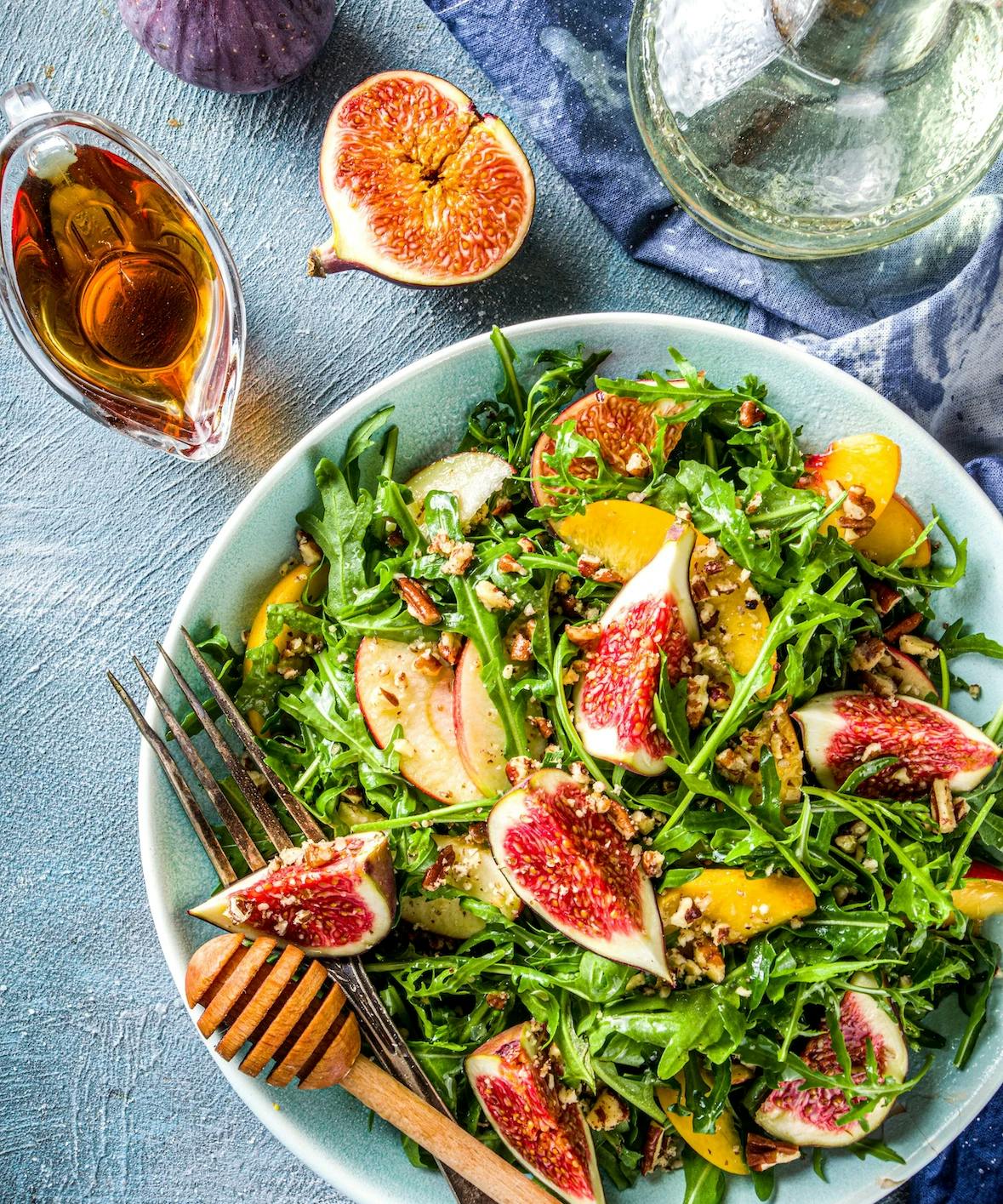Is The Paleo Diet Healthier Than Eating Mediterranean Or Vegan? Here’s What You Need To Know About Eating Like A Cavewoman
Could Paleo actually be the one-diet-to-rule-them-all, or is this hunter-gatherer lifestyle way overhyped?

So many people out there understand that fad diets don’t work, yet there are still those among us who cling to them for a quick “solution” to our problems. And my oh my, there have been more puzzlingly trendy diets over the years than a girl can keep up with – from the South Beach Diet, to the Master Cleanse or Lemonade Diet, to the Raw Food Diet, Whole 30, the Keto Diet and more.
Though I’m not personally a fan of following one strict dietary pattern, one that has piqued my interest over the years has been the Paleo diet for its holistic focus on real ingredients in their least processed or refined form. Yes, on Paleo, you dine exclusively on lean meats, fish, nuts, seeds, vegetables, and fruits as if you were living in the Paleolithic era.
But, now that we’ve experienced many, many thousands of years of progress past the Old Stone Age and have fast food and packaged snacks easily available to fill our stomachs with ultra-processed “food stuff,” could this more rudimentary dietary pattern based on our cave-dwelling ancestors actually be a life-saving health choice? Researchers who led a recent, large-scale meta-analysis of dietary studies seem to think so, so let’s digest their findings as well as the truths and myths of eating Paleo.
Let’s Take a Look at the Research

Before I even begin to dissect the research findings, I need to warn you that this meta-analysis appears to have been industry-funded research published by leading Paleo proponents, The Paleo Diet, but that doesn’t mean we can outright dismiss their findings.
It is worth noting that, of course, an organization or company that publishes its own research would certainly want to make public the most positive information possible, but I am willing to trust their (albeit biased) findings for the following major reason: The study, published in Nutrients in December 2022, was a peer-reviewed, large-scale meta-analysis. A meta-analysis pulls information from smaller studies and is widely accepted by the scientific community as the most reliable way to increase accuracy in research. This can help reduce bias, which is especially important in this case.
Now that I’ve gotten that out of the way, let’s explore their findings. If you’re looking for the “most effective way of eating to simultaneously reduce inflammation, improve blood lipid profiles, and control blood sugar,” your best choice may be to go Paleo.

When the Paleo diet was put to the test against popular diets such as the Mediterranean diet, DASH diet, plant-based diet, dietary guidelines diet (a.k.a. following what our government currently recommends), ketogenic diet, and the standard Western diet, researchers found two major conclusions.
First, the Paleo diet was the best option for reducing the likelihood of chronic disease. In their scoring system, Paleo ranked the highest, then DASH, and then Mediterranean, with the standard Western diet ranking lowest. Their second major conclusion was that specific food choices (and not just focusing on macronutrients like fats or carbs) is the most important factor for improving your health. What this means in practice is eating minimally processed foods in a more natural form instead of focusing on eliminating a particular macro from your diet like going low-carb.
Reducing Inflammation Is Critically Important for Overall Health
What are the leading causes of death and disability in America? Chronic diseases like heart disease, cancer, and diabetes are the worst culprits, causing up to 70% of deaths each year. Reducing your risk factor for chronic disease is a matter of critical importance as our nation grows fatter and sicker. You can do this by eating a more anti-inflammatory diet because certain foods can contribute to the development of autoimmune diseases or stimulate an inflammatory response in your body.
This is where a diet like Paleo plays to its strengths. While the research found that it wasn’t necessarily the best-ranked diet for all biomarkers – Mediterranean beat it out for improving lipid profiles, and ketogenic was better about glycemic control – Paleo combats inflammation better than all other studied diets.
Notoriously problematic foods like hydrogenated vegetable oils, refined sugars, and potentially less problematic foods like gluten, dairy, or legumes are removed, while anti-inflammatory foods like high-fiber fruits and vegetables are welcomed. It makes logical sense – if you’re consuming less salty, sugary, processed foods, reducing alcohol intake, and eating higher amounts of quality protein and fresh produce, you’ll certainly feel less inflamed.

Not only has research shown that Paleo is beneficial for preventing and controlling the aforementioned chronic, noncommunicable diseases, but analysis has also shown that adopting this dietary pattern could help with weight loss. Chronic disease is only worsened by excess weight. In clinical settings, medical practitioners use waist circumference as a vital sign because every 5 cm increase in waist size increases a woman’s risk of death by 13% and a man’s by 17%. What’s more, when dieters in several randomized, controlled trials went Paleo for weight loss, researchers found that there was a mean weight loss of almost 8 lbs.
Wait, So What Do People Actually Eat on Paleo?
So can you achieve a Paleo diet by going to, say, Costco and picking out their trendiest packaged “Paleo” products? Well, if you’re buying Paleo protein bars or mixes for almond flour-based baked goods, you’re still technically eating processed foods.
Paleo purists turn up their noses at these types of products because, to them, replacing non-Paleo ingredients with Paleo swaps misses the point of the diet entirely. They believe in a full-fledged return to eating like a hunter-gatherer would have.
“Do you think Paleolithic humans ate cake – of any kind?” The Paleo Diet explains on their website. “Now, that's not to say that using almond or coconut flour is not a better option than using wheat flour, particularly if one has a gluten sensitivity. But you shouldn’t believe that the cake you’ve made is Paleo. It is still highly processed, low in nutrient-density and contributes to glycemic load.”
This is a pretty fair point to leverage against many of the foods consumers worldwide have grown reliant on. We’ve got the refined flour we’ve come to know and love thanks to steel roller mills being invented in the late 19th century. The Paleo Diet also explains that upwards of 70% of foods in our modern diet were only introduced within the past 10,000 years, so you do have to wonder if we’re actually eating a diet that we evolved to thrive on.
That said, there’s a whole lot of life to miss out on if you completely restrict yourself to whole foods that our cave-dwelling ancestors ate. While it’s true that hunter-gatherer communities had very varied diets based on where they lived and what was able to grow at that particular time, you’re still unnecessarily limiting yourself.
Minimally-processed and unprocessed foods (like bulk grains, eggs, dried pastas, milk, or plain beans/legumes) or processed culinary ingredients (like butter, honey, maple syrup, or refined salts) actually aren’t that bad for you. If you want to adopt a Paleo diet, taking a more lenient approach by buying (or making) minimally-processed Paleo-friendly products or having “cheats” when you’re invited out to drinks or dinner with friends and family might actually help you stay on track with a healthier lifestyle.

A reasonable “cheat” meal – and not a total binge – has been shown to potentially help reduce stress hormones like cortisol, reset your metabolism, aid in insulin regulation, and lift you over a weight-loss plateau. You’ll also be a lot more fun to be around if you’re able to be a bit flexible when eating or drinking in social situations!
Feeling Curious Enough To Try Out Paleo?
Ready to give it a go? The thing about Paleo is that you thankfully won’t need to follow some strict macronutrient profile like you would with a ketogenic diet, for example. The Paleo Diet website recommends about 20-31% of your food intake coming from protein, 31% from carbohydrates, and 38-49% from fat, but you can completely customize your macronutrient ranges. Furthermore, hunter-gatherer populations were neither carnivorous nor vegan, so you’re free to eat as much or as little animal products as you see fit.
One thing you should be very aware of is making sure you protect your hormonal balance while trying out Paleo. While existing hormone imbalances could potentially be aided by cutting out grains, conventional dairy, beans, legumes, and processed foods, a new diet could also exacerbate problems. For example, some women might struggle with gut issues, feel sluggish from eating too few carbs, spike their blood sugar, or accidentally not eat enough to support regular hormonal cycles.
What Might Your Grocery List Look Like?
For meat, you’re free to dine on lean beef, pork, and poultry, game meat like venison, bison, or quail, and both fish and shellfish. To boost your protein intake, you can include eggs.
For fats, you should enjoy all types of nuts like almonds, walnuts, cashews, hazelnuts, Brazil nuts and more, as well as seeds like pumpkin seeds, chia seeds, sesame seeds, and flaxseeds. Use unrefined oils such as olive oil, coconut oil, and avocado oil.
For carbs, get your fill of fruits like berries, apples, citrus, pears, melons and more. You’ll also need to up your vegetable intake with things like cauliflower, broccoli, spinach, carrots, kale, peas, tomatoes, cucumbers, asparagus, and more.
This more restrictive list doesn’t mean you’ll be eating boring meals, however! The internet is filled with Paleo diet-friendly recipes, so you can still eat flavorful, nourishing meals like Mediterranean grilled lamb chops with sweet potato wedges, creamy potato chowder with shrimp and bacon, Chinese chicken and broccoli, pumpkin spice waffles, avocado smoothies, zucchini brownies, bone broth-braised short ribs, and much more.
Closing Thoughts
No one diet is perfect for every person out there, but if a dietary style is focused on whole, clean ingredients that our ancestors thrived on, I’m more trusting that its results could be beneficial for a broad audience!
As someone who loves dairy and legumes, I couldn’t personally follow Paleo to a tee. But, incorporating more Paleo-friendly meals into my rotating repertoire of go-to recipes sounds like a great start to lowering the inflammatory load on my system, reducing my risk of chronic disease, and leading a healthier lifestyle overall!
Don’t miss anything! Sign up for our weekly newsletter and get curated content weekly!